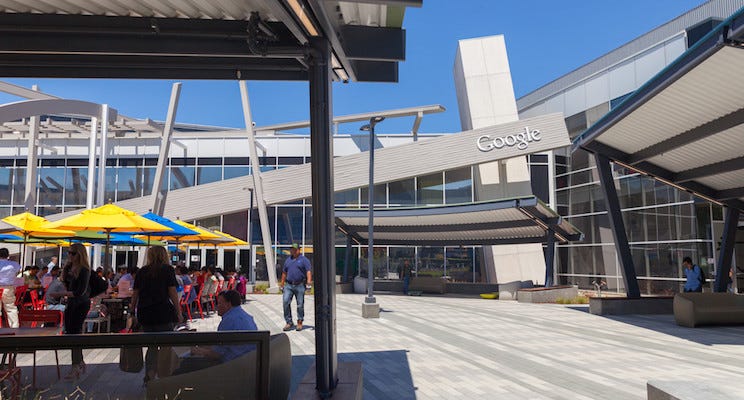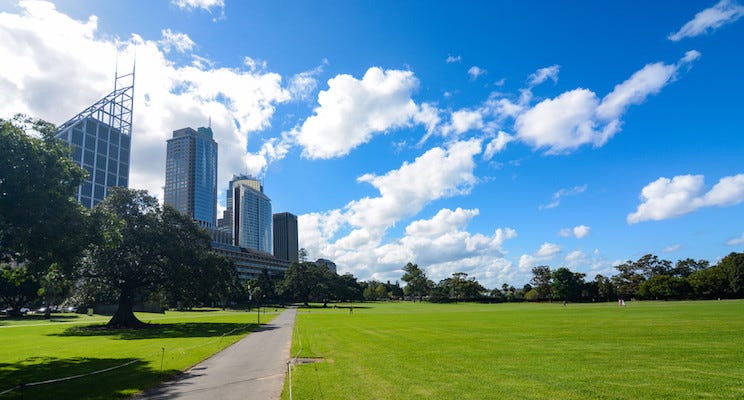Why do we hear so much about swanky San Fran ‘campus-style’ office spaces?

In the world of property after COVID-19, some things have changed and some remain the same. Tenant Leasing Group are specialist advisors on Retail, Large Format, Industrial & Logistics and Head Office property across Australia and New Zealand. Whether you want to find a new warehouse, re-negotiate your retail lease, or get strategic about your office footprint — we find & secure the site you need for the lowest cost. Get in touch today!
Before Bitcoin there were shares — think Microsoft, Apple, Google. Many of us have heard about an old friend or acquaintance, call him Frank, ‘who took a punt in the early 00’s and has two yachts now’… And while the air-time these tech-giants get may have been somewhat encroached upon by crypto, their size & influence — as creators of products, ideas, and new ways of working — remains indisputable.
Tech-giants are a big deal. They’re huge — it’s no small thanks to Silicon Valley & San Fran that California is one of the biggest economies in the world — grossing $US2.747 trillion. And they’re also pioneers and trend-setters. Not only was California the birthplace of ‘the pokies’ (the fellas who really knew how to make money), but it’s also the place that popularised ‘campus-style’ offices — thanks Google — where employees have access to more services & recreational features than you can poke a stick at. Googleplex is famous for having it’s own bus service, restaurants, bike network, courtyards & fun-slides…

Over the past decade, anyone who’s had anything to do with the commercial property space — either as a tenant, agent, or tenant representative — has been inundated with slick videos, images & articles showcasing these sorts of ‘business campuses’, ‘new concept business precincts’, and ‘campus-style’ office spaces. So really,
it’s no wonder we all feel a bit of San Fran’s magnetic pull.
And it’s hard not to idolise the Cali lifestyle — tanned blokes running trails in the sunshine and girls sipping green juice by the pool wearing vintage white sunnies are images that come to mind reflecting on the West Coast. But the ideas of ‘campus-style office environments’and ‘next-gen business precincts’ that we’re frequently asked to buy into, don’t sit quite right.
Asides from broader environmental and economic concerns about campus-style developments, places like Google’s Mountain View campus, which for all it’s fun is located half an hour’s drive from San Jose, and an hour and fifteen minutes from San Francisco, just aren’t practical in most cases in Australia. Here, a thirty kilometre public transport radius around our major cities is the defining factor in where most young professionals live and work. For small-to-medium businesses specifically, your lease is an investment into your business, and reality of a dense inner-business district in most of our major cities is something that should be considered. Whether it be office, commercial, or even retail,
you should be aware of scale and put in what’s going to get you the best, realistic return.
Being a Tenant Representative, I’ve had years of experience understanding what small-to-medium scale businesses are looking for in property. I love my work, and it’s even better when they are as excited as me about finding & nailing down space. But it’s my business to help save them money, so when I get asked about a ‘two-storey office with a cafeteria and a waterslide for a tech-start up in Melbourne’, I’m cautious.
On our East coast, work is concentrated in bustling urban centres. Our CBD’s are tight-packed with high-rise office buildings and boutique café’s. Our suburbs have rigorous zoning & development rules. Sydney and Melbourne in particular are restricted by space, which has seen prime net rents rise, with infill developments becoming much more common.
But there are serious advantages to our cities’ density, which tenants can make the most of. For instance:
when I need to talk to a business about renewal vs. relocation, I can walk from my office in Martin Place to theirs in Barangaroo AND pick up some coffees on the way.
Sydney and Melbourne are small, densely populated hubs of professional services — and it helps us all. For professionals, in particular those making crucial decisions about work spaces for teams, I think it’s so important to embrace the logistical blessings of Australian capital-cities. One emergent office solution that does this — by situating tenants centrally while integrating the ideas seen in larger ‘campus-style’ developments are Co-Working spaces.
When considering moving or developing spaces, think back to that return on investment:
is cost going to be returned to your business through increased productivity?
In retail there’s always been the dollars per square metre efficiency measure — a no-brainer. Office space should be researched with the same rigour, with a mind to determining the real returns on a given redesign, fit-out, or relocation.
This being said, of course there are important principles that can, and should, be adopted from the ‘campus-style office’ and similar narratives. Getting the best out of people should be a top-priority, and this involves considering, as the Harvard Business Review elaborates:how a “space’s design helps or hurts performance”, the right levels of “density, proximity of people” and “the importance of face-to-face interactions”, among other things. What adopting these best-practice designs looks like at a small business level of course isn’t what it’s going to look like at Google. But two campus-style qualities that can be practically adopted in high-rise offices are: communal eating areas & collaborative work spaces. Think simply;
you don’t have to build a café, but try a coffee machine;
have a kitchen space with snacks so people can keep their energy levels up without having to leave the office — you don’t need a full-suite of restaurants (and the chances are that you’ve probably got those in metres walking distance from your building’s front door anyway). Assign teams to the to work on projects in common spaces more often — the boardroom will do.
And as for a Google-style courtyard — in Sydney you’ve got Hyde Park and Circular Quay at your fingertips.

I think it’s great to have a more collaborative forward-thinking approach to new office sites, but I also think
it’s important to make the most of what our cities are: close-knit, connected and beautiful.
Clearly the ‘business campus’ approach isn’t a viable option for most businesses in Australia, especially smaller ones. And in our competitive commercial world, I do think we should be cautious about aspiring to ‘campus-style’ office environments that have been exported out of the US, at risk of not getting the best out of what our own cities have to offer, and failing to ensure the most cost-effective investments in office space for our businesses. We’ve got some great things going on right here, in our own backyard. Our CBD’s are known for their financial and professional services, and the management of our big brands — and staying within this proximity is far more important to me and my business, and many others, than having more space elsewhere.
So, to return to my initial question — why do we gush so much about San Fran and it’s ‘campus-style’ offices & vision of work? Maybe it’s as simple as just being one of those things — not achievable for most of us but slightly more exciting than our own everyday lives:
like watching Masterchef contestants make an earl grey infused Crème Brûlée with popped Tuscan rice and smoked pineapple while you tuck into your Sara Lee sticky date on a Sunday night.
Phil leads TLG with 25+ years experience as a property advisor & tenant representative in Australia and New Zealand.
He specialises in multi-site retail, mixed-use office & industrial, and warehouse leases of up to 5,000sqm.
Trusted by clients, Phil negotiates competitive rentals, incentives, and favourable lease terms for retailers, eCommerce, legal, financial services, and other commercial occupiers.
